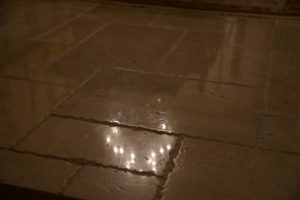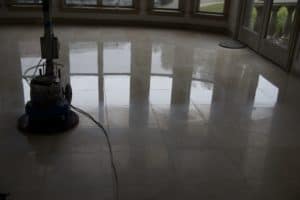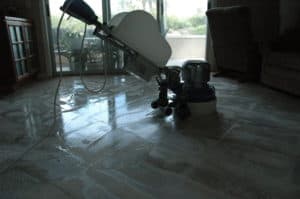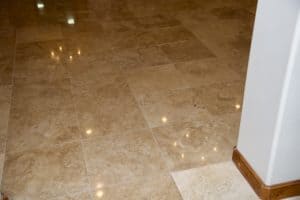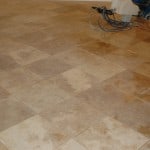Let Us Help Make Your Travertine Floors Shine Like NEW!
Fabric & Tile Masters are the Travertine Polishing Experts of Jacksonville.
Travertine is a beautiful stone — but their finishes are subject to scratches and in some cases etching from low pH chemicals used in inferior cleaning products…
Over time these factors can cause the stone surface (especially if they are polished) to appear worn and lack their original beauty. The polish finish stone is more subject to these factors than is the honed finish stone. The damage will be there in both cases, but the polish finish will show the damage more dramatically.
Travertine polishing is accomplished using abrasive honing powders or diamond disks.
If the travertine is a honed finish as opposed to a polish finish, we often use a honing powder or honing brushes to refinish the floor. Honed finish floors and counter tops often simply require an application of a honing powder and alkaline cleaner, followed by extraction with a heated, high pressure water. Th e honing powder will need to be close to the original finish. On occasion, the hone finish will have deeper etches and scratches than the honing powder can remove. In these cases the surface will need to have deeper cuts to remove the scratch/etch and taken through a grit progression.
Our Travertine Polishing Process
We do not have a cookie cutter process:
The travertine polishing process starts with an analysis of your stone. Our process from start to finish depends entirely on the health of your travertine floors. First, just like any other type of stone the question has to be addressed first about the degree of lippage in the installation.
Notice the portion of the floor on the bottom has been honed and is in the process of being polished.
Travertine Polishing with Grinding
On some installations the tiles look like little buildings sticking up 1/4″ or higher. If there is excessive lippage, the floor will have to be ground flat. Because of the holes in the tiles (and if you have this stone you are well aware of what I am talking about) the fill will be removed during the grinding process. If travertine is involved in the grinding, the stone will have to be floated with an epoxy or non sanded grout to refill the holes.This makes refinishing a travertine floor with excessive lippage, back to a polish finish, one of the most involved process we do in the stone restoration field — and we are one of the few in Northeast Florida with all the proper equipment to do the job the way it is supposed to be completed.
Floor is being ground to remove uneven edges. Lippage removal.
Travertine Polishing without Grinding
If there is no grinding that needs to be done on the floor (the lippage is within acceptable limits) there will only be resin bond diamonds used.
Travertine polishing without grinding requires honing cuts to remove scratch/etch.
Honing powder is not an option and the abrasives used must be diamonds. These industrial diamonds come in a variety of forms. They each have a particular use that when in the hands of our skilled craftsman can polish travertine to a like new factory finish.
The travertine fill can become loose and disappear over the course of time, and will need to be refilled as part of the restoration process.
If you need us to look at your floors and give you our thoughts, please call us at (904) 221-9550 or fill out a request form for a FREE estimate on travertine polishing services.
Other Areas We Serve:
St. Augustine | Ponte Vedra | Atlantic Beach
What is Travertine?
Travertine is a natural stone formed in calcium rich springs and has characteristic holes that are formed by hot spring water bubbling through the stone. These holes are filled when the new slab or tile is going through the production line. Production facilities use epoxy fillers to make the holes even with the tiles.
The travertine is delivered to the distributor in slabs for counters or tiles for floor. If you are making a decision to purchase travertine you need to evaluate the stone based on the amount of fill present in the stone. On the unfinished side of the tile you can see the holes. The larger, and more numerous holes, represent an interior grade of stone. We see more travertine floor than we do any other natural stone. The truth is travertine floors are more frequently installed in our area than all the other natural stone flooring combined.
Here is a video of an exterior travertine we polished.
Here is a commercial travertine refinishing.
A great video showing our work:
Additional Information About Travertine Polishing
The other category of diamond disks are resin bond. These pads are referred to as travertine polishing pads. Resin bond travertine polishing pads can be used for a variety of refinishing situations. After the delippage tools described above are used, in almost every case the scratches formed must be further removed by progressing to a higher grit level. After grinding, a typical resin bond jump off would be to a 30g or 60g resin cut followed by 100g, 220g. If the finish desired is a hone one, the job is pretty much finished. If a polished finish is desired, the resin bond progression would have to proceed to a 400g, 800 followed by a travertine polishing process. The only exception we typically see is if the marble is dark, and we go to a 1500 grit to enhance the polishing process.
There is a chance that if you are reading this you desire to change the floor from a polish to a hone finish or from a polish finish to a honed finish. Either procedure can be achieved. There are times customers purchase a honed finish tile and wish to have it taken to a polish finish immediately after the instillation.
A word about sealers. On a polished finish travertine floor tiles, since the tiles are already sealed during the polishing process (the development of the polished layer is achieved using heat and friction on the production line) the ability of a sealer to penetrate the polished layer is minimal. If the finish is honed, the finish will accept a sealer handily and needs a sealer. A sealer will supply a level of water and oil repellant property after proper application. The sealer will also need to be reapplied after honing the tiles to remove scratches and other damage.
There is also a product available known as an enhancing sealer. This product is used to bring out the color, or essentially darken the stone.
A word about sealers if you are anticipating installing new tiles: have a strategy in mind before you have the installer seal the tiles. Insist on seeing a sample of what the tiles will look like after they have been sealed. A large percentage of our jobs with natural stone include removing and correcting misapplied sealers and enhancers.
Latest posts by Harry Edenfield (see all)
- Atlantic Beach Marble Polishing - May 10, 2020


